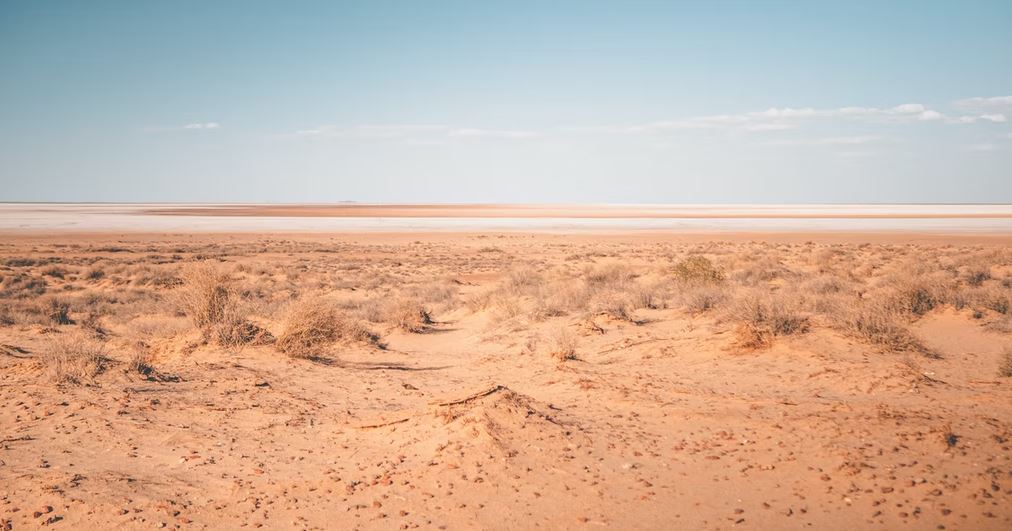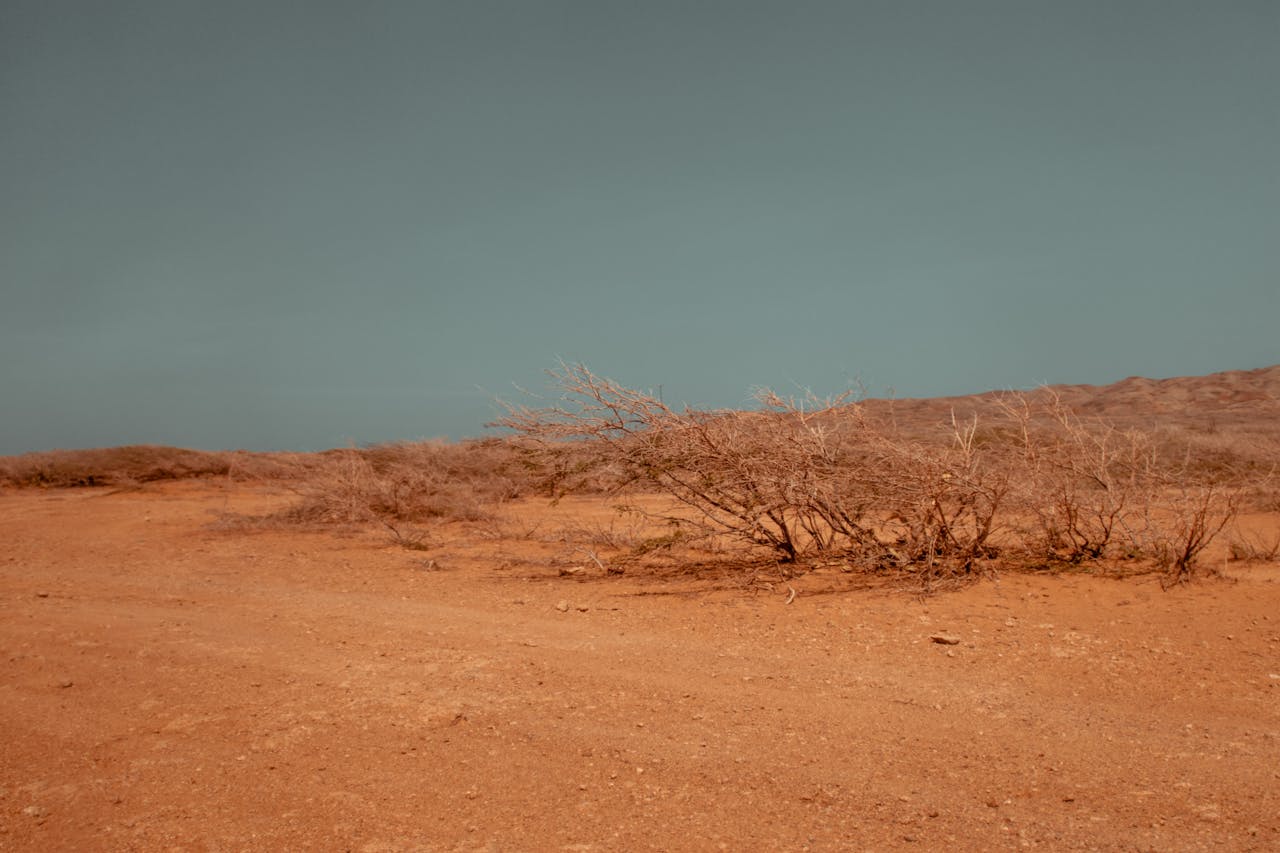How Many Kangaroos Are in Australia? Fascinating Facts About the Iconic Animal
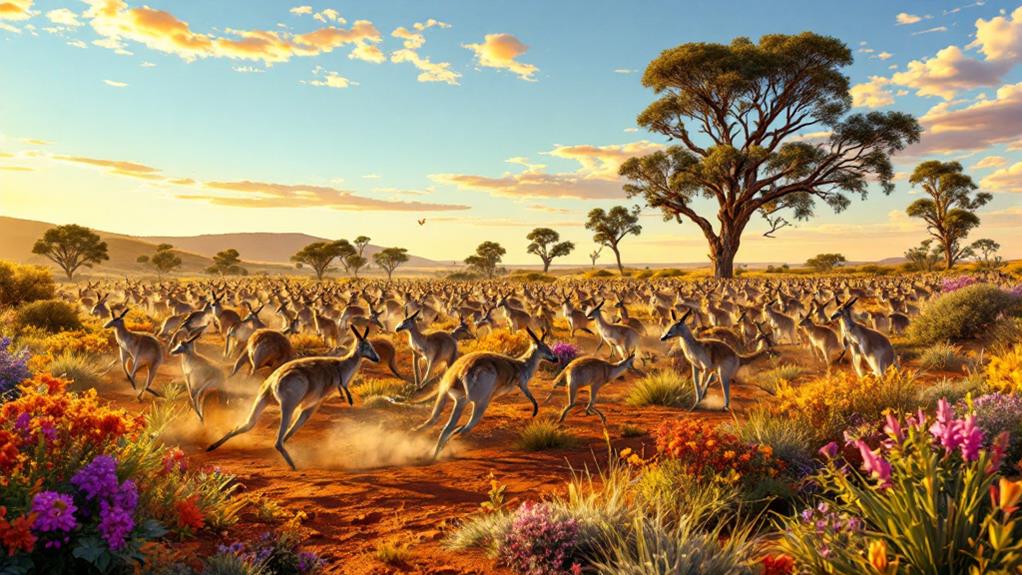
Australia is home to an incredible 50 million kangaroos, making them a prominent feature of the country's diverse landscapes. These iconic animals, including the abundant red and eastern grey species, play essential roles in their ecosystems. Kangaroo joeys are marvels of nature, weighing under 2 grams at birth and developing in their mother's pouch. Kangaroos live in groups called mobs, offering protection and forming strong social bonds. Ancient Aboriginal culture celebrates them as symbols of resilience and agility, evident in artwork and traditions. Don't miss out on uncovering more about these fascinating creatures and their conservation efforts.
Kangaroo Population in Australia
Although often perceived as a symbol of the Australian outback, kangaroo populations in Australia present a complex picture of abundance and conservation. With an estimated 50 million kangaroos roaming the continent, they are among the most populous large mammals. However, their numbers aren't uniformly distributed. The red kangaroo, for instance, thrives in arid and open habitats, making it the most abundant species. In contrast, the eastern grey kangaroo prefers more fertile areas and can be found in considerable numbers in regions with suitable conditions.
Despite their general abundance, kangaroo populations vary considerably by region. Some areas face overabundance, leading to ecological imbalances, while others see declining numbers, particularly in less common species like the Antilopine and Black Wallaroo. Conservation efforts play an important role in managing these dynamics. Regulated hunting and habitat protection are strategies designed to maintain sustainable kangaroo populations.
However, challenges persist. Habitat loss and environmental changes, such as prolonged droughts, threaten their survival and distribution. It is necessary to balance the kangaroo population to guarantee both their conservation and the health of Australia's diverse ecosystems. Understanding these dynamics is critical for effective conservation efforts.
Unique Kangaroo Biology
Diving into the fascinating world of kangaroo biology, you'll find remarkable adaptations that set these marsupials apart. One of the most intriguing aspects is how kangaroos give birth to tiny joeys, weighing less than 2 grams. These joeys develop further in the mother's pouch for about six months, providing a safe and nurturing environment. Female kangaroos can also employ embryonic diapause, a unique reproductive strategy where they pause their pregnancy until conditions are favorable, ensuring the survival of their offspring.
Kangaroos are renowned for their powerful hind legs, which allow them to hop at impressive speeds and cover large distances with minimal energy. Their long feet, however, prevent them from moving backward. Instead, the kangaroo's tail is used as a balancing tool, acting like a fifth limb to aid in stability and locomotion, making their movement efficient and graceful.
When it comes to social interactions, kangaroos exhibit fascinating communication behaviors, such as nose touching, stomping, and growling. They often gather in groups called mobs, which provide protection and social structure. These adaptive traits make kangaroos truly unique and perfectly suited to their environment.
Species Diversity and Characteristics
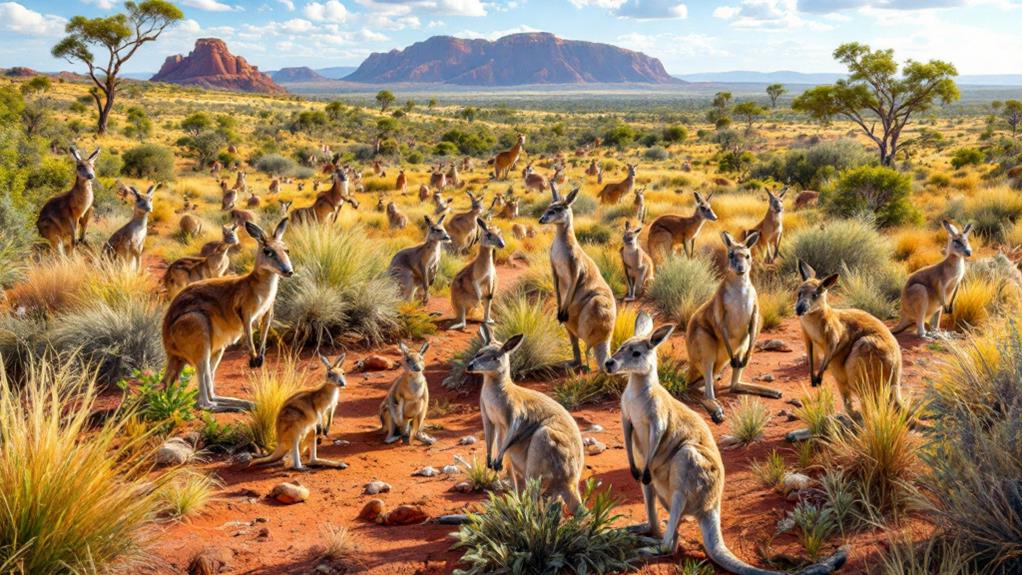
When exploring the diversity of kangaroo species, you'll uncover an astounding variety of sizes, shapes, and behaviors across approximately 60 different types of kangaroos and wallabies. Each species exhibits unique physical characteristics and adapts to specific habitats. The red kangaroo stands out as the largest, towering up to 2 meters (6 feet) and weighing around 90 kg (200 pounds). In contrast, the musky rat kangaroo, about the size of a rabbit, highlights the incredible range in size among these species.
The eastern grey kangaroo is widely recognized for its soft grey fur and powerful hind legs, which allow it to navigate the varied landscapes of eastern Australia. Meanwhile, the western grey kangaroo, with its two distinct subspecies, showcases the subtle variations within species diversity based on geographic distribution. These kangaroos thrive in open woodlands and scrublands, adapting to the unique environments of western and southern Australia.
Adding to the diversity, tree kangaroos have evolved to inhabit rainforest canopies, demonstrating the adaptability of kangaroos to different habitats. This rich tapestry of species diversity underscores the remarkable evolutionary paths these iconic animals have taken across the Australian continent.
Kangaroo Social Structures
Kangaroos exhibit fascinating social structures by living in groups called mobs, which can range from small gatherings of about 10 to large assemblies of over 100 individuals. These mobs offer advantages like safety and social interaction, essential for survival in the wild. Within these groups, social structures are clearly defined, often led by dominant males known as boomers. These boomers assert their leadership through impressive displays of strength, maintaining order and protecting their group.
You'll find that kangaroos have developed intricate communication methods to thrive within their mobs. Mother kangaroos, or jills, use clicking or clucking sounds to communicate with their young, strengthening their bond. Among the broader mob, kangaroos engage in different forms of social interactions. Nose touching, stomping, and growling are just a few ways they communicate, reflecting their complex social behaviors and ensuring cohesion.
Additionally, smaller sub-groups within mobs allow kangaroos to manage resources effectively and engage in dynamic interactions. This structure helps distribute resources among the population, ensuring a balanced social environment. By understanding these social structures, you gain insight into how kangaroos live in groups and maintain harmony within their communities.
Cultural Importance of Kangaroos
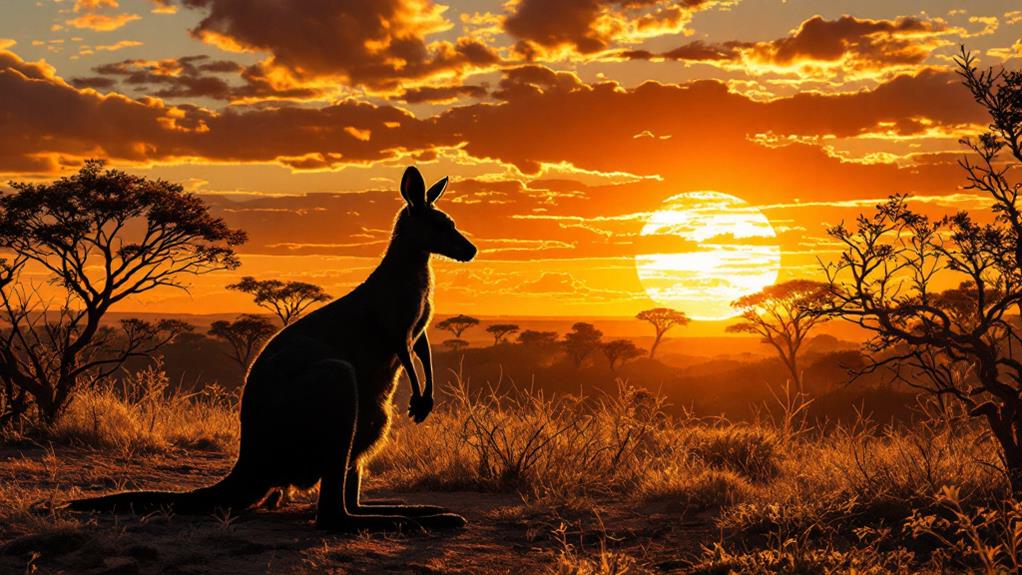
In the heart of Australian culture and history, kangaroos hold a profound significance that transcends mere symbolism. For Aboriginal people, these magnificent creatures embody cultural importance, symbolizing resilience and adaptability. Through traditional stories and art, kangaroos teach lessons of survival and harmony with nature. Their presence is not just a motif but a representation of a longstanding connection to land and environment.
The word "kangaroo" itself derives from the Indigenous language, specifically the word "gangurru." This linguistic origin underscores their deep-rooted significance in Aboriginal heritage. You can find ancient rock paintings, dating back tens of thousands of years, depicting kangaroos across Australia. These artworks highlight the integral role kangaroos have played in storytelling and spiritual beliefs for generations.
In modern Australia, the cultural importance of kangaroos extends beyond Aboriginal traditions:
- National Symbols: Kangaroos are featured on the Australian Coat of Arms, representing a forward-moving nation.
- Sports: They're mascots for diverse Australian sports teams, symbolizing agility and strength.
- Art and Storytelling: In Indigenous art, kangaroos convey messages about environmental stewardship.
- Heritage: Their image is a constant reminder of Australia's rich cultural tapestry.
Kangaroo Conservation Efforts
Conserving kangaroos isn't just about maintaining a species; it's about preserving an important piece of Australia's ecological and cultural landscape. With over 50 million kangaroos roaming the country, kangaroo conservation is significant, especially as some populations face threats from habitat loss and hunting. To guarantee sustainable populations, regulated hunting quotas are set, allowing the harvest of up to five million kangaroos annually. This careful management helps balance the species' numbers and the environment they inhabit.
Ethical treatment is a key focus in conservation efforts. Legislative measures, like those in New York aiming to ban kangaroo leather, underscore the importance of treating these animals with respect. But it's not just about laws; community involvement plays an important role. Organizations work tirelessly to rescue and rehabilitate injured kangaroos, encouraging communities to participate in conservation initiatives.
Efforts extend beyond individual animals to include habitat protection. Removing introduced herbivores that compete with kangaroos for resources is part of broader strategies to restore ecosystems. By addressing these challenges, you can help maintain a healthy balance, guaranteeing that kangaroos continue to thrive as an iconic symbol of Australia's wildlife heritage.
Kangaroo Diet and Habitats
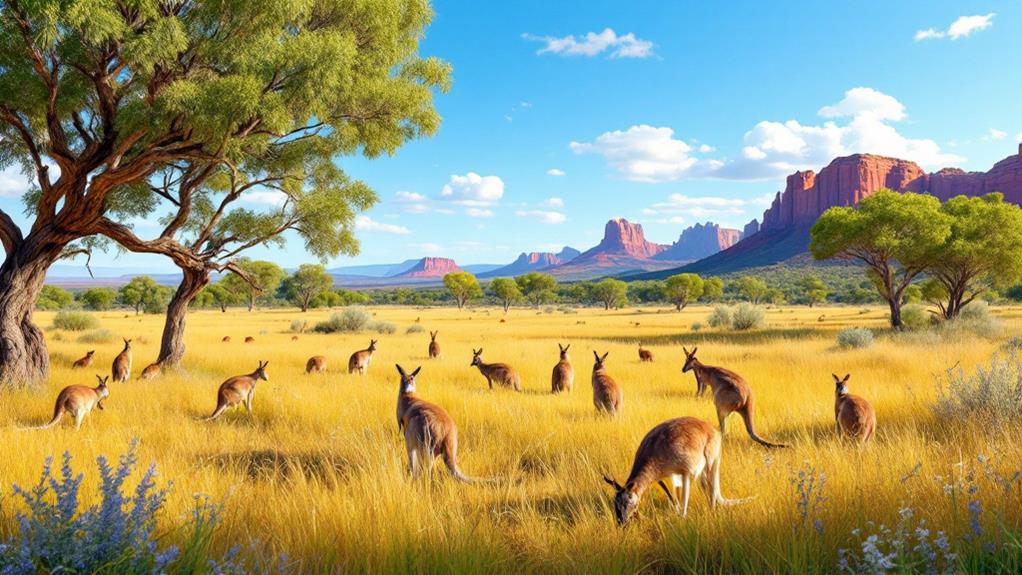
While efforts to conserve kangaroos are crucial for their survival, understanding their diet and habitats plays an equally significant role in these initiatives. Kangaroos are strict herbivores, meaning their diet mainly consists of grasses, leaves, and other plant materials. This specialized kangaroo diet is supported by their chambered stomach, which efficiently breaks down fibrous plant matter.
Kangaroos thrive in diverse environments across Australia, showcasing their adaptability. From lush grasslands and dense forests to arid scrublands, they inhabit a range of habitats. This adaptability allows them to survive in varying climates, even in urban areas where food and shelter are accessible.
Here are some key points about their foraging habits and habitat adaptability:
- Foraging Patterns: Kangaroos typically forage during dawn and dusk, taking advantage of cooler temperatures.
- Moisture Extraction: They extract moisture from their food, reducing their need for direct water sources in arid habitats.
- Urban Presence: Increasingly, kangaroos venture into urban areas, where they find new habitats.
- Protected Areas: National parks and reserves frequently house these iconic animals, ensuring their safety.
Interaction With Kangaroos
You might find kangaroos fascinating not only for their iconic hopping but also for their unique social interactions. In kangaroo groups, often called mobs, communication is key. They use a range of vocalizations, such as hissing, growling, and clicking, to convey messages during courtship or when calling out to their young. Mother kangaroos, in particular, have a special bond with their joeys. They use clucking sounds to call them, reinforcing the fundamental mother-young connection.
Social interactions among kangaroos go beyond vocal communication. You'll observe behaviors like nose touching and stomping, which play a significant role in establishing and maintaining bonds within their groups. Grooming is another important activity, not just for hygiene but also for strengthening these social ties.
When danger lurks, joeys instinctively seek safety by diving headfirst into their mother's pouch. This protective behavior highlights the deep bond between mothers and their young. These interactions exhibit the complexity of kangaroo social structures, where relationships are formed and maintained through a mix of sounds, gestures, and physical contact, creating a fascinating dynamic in the animal kingdom.

